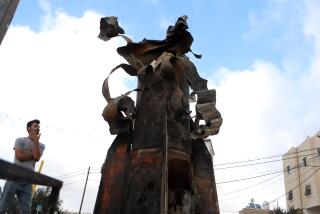As Japan’s premier visits Tehran, here’s what you need to know about U.S.-Iran tensions

Tensions have been brewing between the U.S. and Iran since Iran’s Islamic Revolution four decades ago, but the situation reached a boiling point last month after the U.S. claimed an increased threat from Iran, a year after pulling out of a multi-nation nuclear treaty with Tehran.
The rhetoric has simmered, and both sides have insisted they do not seek war. But concerns remain that the situation could quickly change and shoot past the boiling point.
One reason for continued worries is that Iran and the U.S. don’t have any direct line of communication. It’s become a national security dilemma that’s left both sides vulnerable to misinterpreting each other’s actions.
On Wednesday, Japanese Prime Minister Shinzo Abe traveled to Tehran — the first time a sitting Japanese premier has visited the country in the 40 years since its Islamic Revolution — to act as mediator between the two feuding nations. His trip was the highest-level diplomatic effort so far aimed at lowering the rhetoric as Iran appeared ready to break the 2015 nuclear deal.
Whether Abe will be successful in his efforts remains to be seen. Experts say that problems between the U.S. and Iran have intensified since a series of events left politicians and the international community worried the two nations were edging toward a military conflict.
Also, whether it’s Iran’s nuclear ambitions, conflicting goals in the Middle East or issues of human rights, the nations have continued to clash on numerous fronts over the last several decades. Here’s an explanation of how relations took a turn for the worse and where things stand today.
What caused the recent flare-up in tensions?
The impetus for the most recent uptick in tensions, analysts say, was the Trump administration’s decision to label Iran’s Islamic Revolutionary Guard Corps as a foreign terrorist organization. In retaliation, Iranian lawmakers on April 8 designated U.S. forces in the Middle East as a terrorist group.
About a month later, President Trump’s hawkish national security advisor, John Bolton, announced the Pentagon would deploy the Abraham Lincoln Carrier Strike Group and Air Force B-52 bombers to the Persian Gulf. Bolton said the move was in response to “a number of troubling and escalatory indications” by Iranian security forces.
U.S. officials claimed they had intelligence that showed Iran’s Islamic Revolutionary Guard Corps had put cruise missiles aboard small boats, threatening American naval ships in the Persian Gulf.
Less than a week later, President Hassan Rouhani announced Iran would stop complying with some parts of the landmark nuclear pact, which was signed in 2015, unless other signatories of the deal — Britain, France, Germany, Russia and China — helped protect it from U.S. sanctions, which have crippled its economy.
Until then, Iran said it would continue to follow the terms of the treaty, which curbed Tehran’s nuclear programs despite the U.S. having reimposed tough economic sanctions on Iran after it pulled out last year.
Rouhani said it was giving the other signatories of the deal 60 days to figure out a plan to help. After that, Rouhani said Iran would consider resuming enrichment of uranium at a higher level than what was allowed under the deal and start developing its Arak heavy water reactor based on plans it had before the nuclear deal was signed.
Those countries are going to have a tough time pulling off a plan that appeases Iran. Hours after Rouhani made the announcement, the Trump administration said it was imposing additional economic sanctions that would target Iran’s iron, steel, aluminum and copper industries.
What happened next?
Over the course of the next several weeks in May, as U.S. and Iranian officials responded to each other’s moves, tensions grew worse.
Citing growing fears of a potential conflict with Iran, the State Department ordered hundreds of its personnel to leave its next-door neighbor, Iraq, leaving politicians in the U.S. and abroad voicing fears that the two countries were on the brink of a military conflict.
Then on May 13, officials in Saudi Arabia blamed Iran-backed Houthi rebels for explosions reportedly caused by floating mines and drones that damaged several of its oil tankers near the Strait of Hormuz. The U.S. has accused Iran of being behind the attacks but has not released evidence to back up its claim.
In the days before the Saudi oil tank explosions, the U.S. began moving its aircraft carrier strike group, four B-52 bombers and Patriot missile batteries into the region. U.S. officials also announced they would be sending 900 additional troops to the region and extending the deployment of 600 troops.
In the midst of these moves, hostile rhetoric between the two nations worsened, adding fuel to the fire.
On May 19 Trump tweeted: “If Iran wants to fight, that will be the official end of Iran. Never threaten the US again!”
In Iran, hardliners slapped back.
“If they commit the slightest stupidity, we will send these ships to the bottom of the sea along with their crew and planes using two missiles or two new secret weapons,” Gen. Morteza Qorbani, an adviser to Iran’s military command, told Iran’s semiofficial news agency Mizan.
Where do things stand now?
Tensions have since eased a bit.
On May 24, Trump said the U.S. was not seeking war with Iran and that he’d be open to having direct talks with Iran’s Supreme Leader Ayatollah Ali Khamenei. He reiterated that point a few days later and said the U.S. was “not looking for regime change” in Iran.
U.S. Secretary of State Michael R. Pompeo also announced last week that Washington would be open to speaking to Iran with no preconditions. After Pompeo’s trip to Switzerland, there’s also been speculation that the Swiss government might spearhead back-channel communications between Iran and the U.S.
However, the possibility of conflict is not off the table.
Asked whether he would take military action against Iran in an interview June 5 with British television station ITV, Trump said: “There is always a chance. Do I want to? No, I’d rather not. But there’s always a chance.”
How have Iranian officials reacted ?
Khamenei and the more moderate Rouhani have sought to ease concerns and said in recent weeks that Iran did not seek war with the U.S.
It’s unclear whether Iranian officials will take up Pompeo’s offer for talks. Foreign Ministry spokesman Abbas Mousavi told Mehr news agency last week that “Iran does not pay attention to wordplay and expression of hidden agenda in new forms.”
It doesn’t help that Washington has sent mixed signals. That can create confusion and stir up deep-rooted mistrust about the U.S.
Iranian officials’ apprehensiveness toward the U.S. stems from events in 1953, when the CIA helped orchestrate a coup that overthrew democratically elected Prime Minister Mohammed Mossadegh, replacing him with the exiled Shah Mohammad Reza Palavi. Those events eventually led to Iran’s 1979 revolution, which overthrew the Western-backed monarchy and replaced it with Islamic religious rule.
How real is the risk of war?
Both nations have said publicly they don’t want war, lessening the chance of combat.
But the situation remains fragile, and there is a possibility both nations might inadvertently inch closer to conflict again, says Ariane Tabatabai, an associate political scientist at the Rand Corp.
One reason is the limited lines of communication, which can result in the two sides misreading intentions.
“Both Iran and the U.S. are taking actions to deter the other from attacking,” Tabatabai said. “Those actions, which are meant to be deterrents, could be viewed as aggressive by the other side.”
Dalia Dassa Kaye, director of the Center for Middle East Public Policy at the Rand Corp., said there’s potential for an accidental clash in Iraq between Iran-backed militias and the U.S. If that were to happen, it could be a catalyst spiraling the U.S. and Iran into armed conflict, she said.
A telling sign may be if Iran stops complying with parts of the nuclear agreement after the 60 days are up.
“We may get back to a situation where escalation happens again,” Tabatabai said.
Follow me on Twitter @melissaetehad
More to Read
Sign up for Essential California
The most important California stories and recommendations in your inbox every morning.
You may occasionally receive promotional content from the Los Angeles Times.











